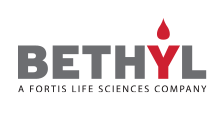NEW!
Rabbit anti-XRN2 IHC Antibody Affinity Purified

Bethyl Laboratories
Catalog #
Validated
Target:
XRN2
Reactivity:
Human
,Mouse
Applications:
IHC
,IHC-IF
Host:
Rabbit
Clonality:
Polyclonal
Format:
Whole IgG
Immunogen:
Between 900 and 950
Isotype:
IgG
Conjugate:
Unconjugated
Purity:
Antigen Affinity Purified
100 µl (50+ slides)
10 µl (5+ slides)
Product Details
Specifications
Verified Reactivity
Mouse,
Human
Presumed Reactivity
Monkey
Antigen Species
Human
Concentration
250 µg/ml
Storage
2 - 8 °C
Shelf Life
1 year from date of receipt
Physical State
Liquid
Buffer
Production Procedures
Antibody was affinity purified using an epitope specific to XRN2 immobilized on solid support.
The epitope recognized by IHC-00223 maps to a region between residue 900 and 950 human 5'-3' exoribonuclease 2 using the numbering given in entry NP_036387.2 (GeneID 22803).
Immunoglobulin concentration was determined using Beer’s Law where 1mg/mL IgG has an A280 of 1.4.
Antibody was affinity purified using an epitope specific to XRN2 immobilized on solid support.
The epitope recognized by IHC-00223-T maps to a region between residue 900 and 950 of human 5'-3' exoribonuclease 2 using the numbering given in entry NP_036387.2 (GeneID 22803).
Immunoglobulin concentration was determined using Beer’s Law where 1mg/mL IgG has an A280 of 1.4.
Additional Product Information
XRN2 is a 5’-to-3’ exoribonuclease involved in 3’-end mRNA processing. XRN2 is important for transcription termination and is responsible for degrading the downstream 3’-end-cleaved RNA. Recent studies show that XRN2 is recruited to 3’-end processing machinery by p54nrb/PSF.
Alternate Names
5'-3' exoribonuclease 2; Dhm1-like protein; DHP protein
Applications

